HISTORY
Paper – II
Note : This paper contains fifty (50) objective type questions of two (2) marks each. All questions are compulsory.
1. Which of the following are true of the Mesolithic period ?
Select your answer from the code given below :
(i) Microliths are found in general.
(ii) Bagor, Langhnaj and Bhim-betka are some important sites.
(iii) Bones of wild and domesticated animals are found.
(iv) Rock-paintings are available during this period.
Code :
(1) i, ii, iii and iv
(2) i, ii and iii
(3) ii, iii and iv
(4) i, ii and iv
2. Which of the following Neolithic archaeological sites is not known for ash-mounds?
(1) Utnur
(2) Pallavoy
(3) Kupgal
(4) Burzahom
3. Which of the following sites has yielded a short inscription written in Harappan script with huge alphabets ?
(1) Banawali
(2) Dholavira
(3) Kalibangan
(4) Mohenjodaro
4. Which of the following pairs is wrongly matched ?

5. Match List – I with List – II and select the correct answer from the code given below :

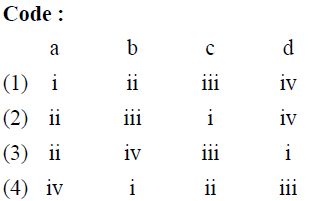
6. With which of the following departments was Kantaka-Sodhana connected ?
(1) Taxation
(2) Industry
(3) Tolls
(4) Judiciary
7. Which one of the following is wrongly matched ?
Tax-term Connotation
(1) Vishti – Forced labour
(2) Bhaga – Local tax
(3) Kara – Tax
(4) Pranaya – Emergency tax
8. Which of the following is not a part of the Buddhist architecture ?
(1) Anda
(2) Medhi
(3) Chhatra
(4) Antarala
9. Which of the following statements is true of the Kushan period ?
(1) Issue of silver coins on a large scale.
(2) Flourishing of the Gandhara art.
(3) Patronage of Amarasimha.
(4) Extension of the empire up to Bengal.
10. Which of the following statements are known from the Hathigumpha inscription of Kharavela ?
Select your answer from the code given below :
(i) He was a ruler of Kalinga.
(ii) He describes himself as a Mahameghavahana.
(iii) He convened a Council of Jain scholars.
(iv) He enlarged the canal originally excavated by a Nanda King,up to the city.
Code :
(1) i, ii, iii and iv
(2) i, ii and iii
(3) ii, iii and iv
(4) i, ii and iv
11. Which of the following statements are made in the Periplus of the Erythraean sea ?
Select your answer from the code given below :
(i) Colchi, Camara and Poduca were South Indian ports.
(ii) Ivory was produced in Dosarene.
(iii) Large ships called Colandia sailed to the Ganges and Chryse.
(iv) Masalia lay to the south of Muziris.
Code :
(1) i, ii and iii
(2) iii and iv
(3) ii, iii and iv
(4) i, ii and iv
12. Match List-I with List-II and select the correct answer from the code given below :

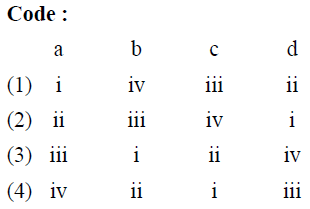
13. Given below are two statements, one labelled as Assertion (A) and the other as Reason (R) :
Assertion (A) : Fa-hien visited India during the time of Chandragupta II.
Reason (R) : He described Chandragupta II as ruling from his capital at Pataliputra.
In the context of the other two statements which of the following is correct ?
Codes :
(1) Both (A) and (R) are true and (R) is the correct explanation of (A).
(2) Both (A) and (R) are true, but (R) is not the correct explanation of (A).
(3) (A) is true, but (R) is the false.
(4) (A) is false, but (R) is true.
14. Arrange the following Astronomers in a correct chronological order :
(i) Aryabhata (ii) Brahmagupta
(iii) Lagadha (iv) Varahamihira
Select the correct answer from the code given below :
Code :
(1) I, III, II, IV
(2) II, IV, III, I
(3) III, I, IV, II
(4) IV, II,III, I
15. Match List-I with List-II and select the answer from the code given below :

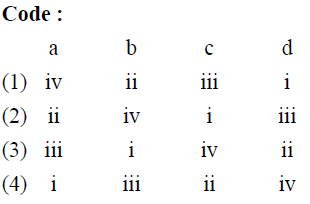
16. Who, among the following, were not a South Indian mercantile/maritime organisation ?
(1) Anjuvannam
(2) Manigramam
(3) Ainnurruvar
(4) Mahajanas
17. Which of the following statements are true in respect of the Kingdom of Srivijaya ?
Select the answer from the code given below :
(i) Devapala of the Pala family granted villages for the maintenance of a Buddhist monastery built by Balaputradeva.
(ii) Chola Rajaraja I had cordial relations with the Kingdom of Srivijaya.
(iii) Rajendra I’s relations with Srivijaya were initially friendly, but later inimical.
(iv) Mara Vijayottugavarman built a Buddhist monastery at Nagapatinam.
Code :
(1) i, ii, iii and iv
(2) i, ii and iii
(3) ii, iii and iv
(4) i, iii and iv
18. Match Persian/Arabic texts given in List-I with its composers given in List-II and select the correct answer from the code given below :


19. “During the entire period of khani and kingship of well over 40 years he never talked to bazaar people, the base, mean, musicians and buffoons.”
In the above statement Ziauddin Barani is referring to which of the following Sultan ?
(1) Nasiruddin Mahmud
(2) Balban
(3) Alauddin Khalji
(4) Muhammad bin Tughluq
20. Which of the following city was named Khizrabad by Alauddin Khalji after his son Khizr Khan ?
(1) Lakhnauti
(2) Ranthambhor
(3) Chittor
(4) Mandu
21. The fourteenth century saint-poetess Lalla Ded’s verses are known as :
(1) Var
(2) Vaakh
(3) Lalkavya
(4) Spanda
22. Ziauddin Barani records that inspite of ban on wine “addicts libertines and debauched people built Bhattis in their houses and distilled wine… and themselves consumed it and secretly sold it at higher costs.”
In the above statement Ziauddin Barani is referring to which of the following Sultan who prohibited consumption and sale of wine in his dominion ?
(1) Balban
(2) Alauddin Khalji
(3) Muhammad Bin Tughluq
(4) Firoz Shah Tughluq
23. Arrange the following Chak rulers of Kashmir in chronological order :
(i) Sultan Muhammad Shah I
(ii) Sultan Hasan Shah
(iii) Sultan Fateh Shah
(iv) Sultan Haidar Shah
Select your answer from the code given below :
Code :
(1) (i), (ii), (iii), (iv)
(2) (ii), (i), (iv), (iii)
(3) (iv), (ii), (i), (iii)
(4) (iii), (iv), (ii), (i)
24. ‘It is their custom that the person to whom this (platter containing ‘betel’) is brought out takes the platter in his hand, places it upon his shoulder and then does homage with his other hand touching the ground.’
Who among the following wrote this while mentioning the feasts arranged by Sultan Muhammad Tughluq for his nobles and for foreign visitors ?
(1) Abdur Razzaq
(2) Ibn Battuta
(3) Mirza Nathan
(4) Shams Siraj Afif
25. Who gave the following arguments for understanding his work Ma’danu’sh Shifa-i Sikandarshahi ?
‘First, that the Greek medicine did not suit the climate of India, and secondly, that the medicinal plants mentioned in that system were either unidentifiable or unobtainable in India.’
(1) Ali Muhammad Khan
(2) Milhana
(3) Mir Masum
(4) Miyan Bhuwah
26. Which one of the following works was commissioned by Aurangzeb to compile authoritative passages from the standard works of Hanafi fiqh for the guidance of the qazis ?
(1) Siyasat Nama
(2) Nasihat-ul Muluk
(3) Ahkam i Alamgiri
(4) Fatawa al-Alamgiri
27. Whom did Abul Fazl style ‘Sada Lahu’ (‘simple one’) because he mourned the loss of the idol he used to worship, and call him ‘a blind follower of custom’ ?
(1) Todar Mal
(2) Man Singh
(3) Tansen
(4) Birbal
28. Match List- I with List-II and select your answer from the code given below :
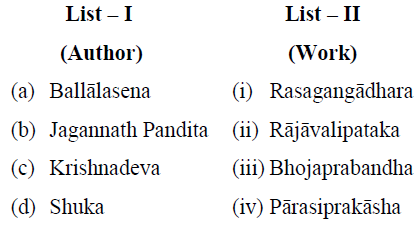

29. Point out which of the following is/are not a form of Hundi ?
(i) Zabti Hundi
(ii) Darshani Hundi
(iii) Miyadi Hundi
(iv) Faslana Hundi
Choose your answer from the code given below :
Code :
(1) (i) and (ii) only
(2) (i) and (iv) only
(3) (ii) and (iii) only
(4) (iii) and (iv) only
30. Arrange the following historical monuments in chronological order :
(i) Humayun’s Tomb – Delhi
(ii) Atala Mosque – Jaunpur
(iii) Rabia Daurani’s Tomb – Aurangabad
(iv) Sher Shah’s Tomb – Sasaram
Select your answer from the following code :
Code :
(1) (i), (iii), (ii), (iv)
(2) (ii), (iv), (i), (iii)
(3) (ii), (iii), (iv), (i)
(4) (ii), (i), (iii), (iv)
31. Which of the following Mughal royal woman assigned land from her jagir for grazing cows ?
(1) Hamida Bano Begum
(2) Maham Anga
(3) Nur Jahan
(4) Mumtaz Mahal
32. Which of the following is not correct ?
(1) In sarkar, a territorial division of a suba, a number of officials were appointed.
(2) The highest officer of a sarkar was called faujdar.
(3) One of the officers was called pradhan of the sarkar.
(4) The duty of the faujdar was to maintain law and order in his sarkar.
33. During his conversation with Aurangzeb Mirza Mukarram Safavi asked him to express his views on music. Which of the following statement/s of Aurangzeb is/are true on music ?
(i) Music was ‘mubah’, neither good nor bad.
(ii) I dislike instrumental and vocal music.
(iii) I cannot listen to music without flutes especially Pakhawaj.
(iv) Flutes are unanimously prohibited (harām) so I left music.
Select the correct answer from the code given below :
Code :
(1) (i) and (ii)
(2) (ii) and (iii)
(3) (ii) and (iv)
(4) (i), (iii) and (iv)
34. Chronologically arrange the following celebrated buildings built by Shahjahan :
(i) Diwan-i Ām in Agra Fort (ii) Moti Masjid in Agra Fort
(iii) Taj Mahal, Agra (iv) Jama Masjid, Shahjahanabad
Select the correct answer from the code given below :
Codes :
(1) (i), (iii), (ii), (iv)
(2) (ii), (iii), (i), (iv)
(3) (iii), (ii), (iv), (i)
(4) (iii), (iv), (ii), (i)
35. Which system was declared illegal in India by the India Act V of 1843 ?
(1) Sati
(2) Infanticide
(3) Slavery
(4) Dowry
36. Given below are two statements, one labelled as Assertion (A) and the other labelled as Reason (R) :
Assertion (A) : Chiefs’ colleges in India was founded to provide education for the princely and aristocratic families of India.
Reason (R) : Natives were desirous to be taught in English and not to be taught in native languages.
In the context of the above statements, which of the following is correct ?
Code :
(1) Both (A) and (R) are true and (R) is the correct explanation of (A).
(2) Both (A) and (R) are true, but (R) is not the correct explanation of (A).
(3) (A) is true, but (R) is false.
(4) (A) is false, but (R) is true.
37. Who among the following did not endorse the view that the protected princes in India were mere ‘feudatories’ of the British Crown ?
(1) Sir Lewis Tupper
(2) Wheaton
(3) Duke of Argyll
(4) Sir William Lee Warner
38. Arrange chronologically the following Famine Commissions :
(a) Macdonnell (b) Strachey
(c) Lyall (d) Campbell
Select the correct answer from the code given below :
Code :
(1) (c), (a), (d), (b)
(2) (b), (c), (a), (d)
(3) (d), (b), (c), (a)
(4) (a), (c), (d), (b)
39. When was the first Factory Act was passed by the British Colonial Government ?
(1) 1867
(2) 1876
(3) 1881
(4) 1884
40. Which one of the following was not the declared objective for the founding of the All India Muslim League ?
(1) Propagate the Ideology of pan-Islamism among the Indian Muslims.
(2) Plead with the British Government about the political rights and interests of the Indian Muslims.
(3) Promote among the Indian Muslims feelings of loyalty to the British Government.
(4) To prevent the rise among the Indian Muslims of any feelings of hostility towards other communities.
41. Who among the following were the members of Khilafat Committee ?
(a) Shaukat Ali
(b) Hakim Ajmal Khan
(c) Hasrat Mohani
(d) Mustafa Nasaruddin
Select the correct answer from the code given below :
Code :
(1) (a), (b) and (d)
(2) (a), (c) and (d)
(3) (a), (b) and (c)
(4) (b), (c) and (d)
42. Match List-I with List-II and select the correct answer with the help of the code given below :

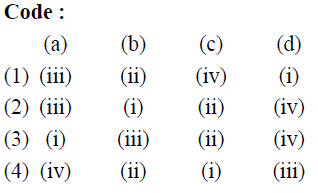
43. Which among the following Act was described as a ‘new charter of bondage’ by Jawaharlal Nehru ?
(1) Indian Criminal Law Amendment Act, 1913
(2) Rowlatt Act, 1919
(3) Government of India Act, 1919
(4) Government of India Act, 1935
44. Who among the following condemned the Ottawa Trade Agreement of 1932 by saying that : ‘it has killed much larger interests of India’ ?
(1) G.D. Birla
(2) J.R.D. Tata
(3) Jawahar Lal Nehru
(4) J.B. Kripalani
45. Who among the following did not belong to the ‘Liberal Party’ ?
(1) Dinshaw Petit Ali Iman
(2) Purshottam Das Thakur
(3) S.M. Paranjpye
(4) V.S. Srinivasa Sastri
46. Which one of the following would not be a necessary condition for being a ‘Nation-State’ ?
(1) A State organized for the Government of a Nation or closely related Nations.
(2) A State whose territory is determined by National boundaries.
(3) A State whose law is determined by National customs and aspirations.
(4) A Nation is the expression of the State.
47. Which of the following Articles of the Indian Constitution guarantees complete equality of men and women ?
(1) 12 and 13
(2) 14 and 15
(3) 18 and 19
(4) 49 and 50
48. Who among the following was a great innovator in Politics. Being fully and consciously secular, he understood, more clearly the danger that communalism posed to the nation. He often told that communalism was as big an enemy as colonialism.
(1) Chandrashekhar Azad
(2) Bhagwati Charan Vohra
(3) Yashpal
(4) Bhagat Singh
49. Who among the following was not the member of the States Reorganization Commission ?
(1) Justice Syed Fazl Ali
(2) Dr. Hriday Nath Kunzru
(3) K.M. Panikkar
(4) Sasipada Banerji
50. Who coined the term ‘positivism’ and was the founder of positivist philosophy ?
(1) Niebuhr
(2) Ranke
(3) Auguste Comte
(4) Thomas Buckle
Latest Govt Job & Exam Updates: